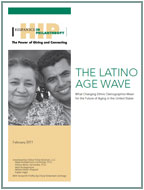I have to be honest. I don’t particularly care for the “silver tsunami” metaphor that people in my field often use when talking about the dramatic demographic shifts underway as the baby boomers age. With recent natural disasters making the images all too horrific, I worry that the assets and opportunities of an aging population are too easily swept aside. It’s too easy to feel overwhelmed by the problems.
 Still, the image goes a long way in conveying the enormity of the situation and the urgency needed, particularly in fixing our broken health care system to better serve the most vulnerable and frail elderly. If “silver tsunami” helps to get attention, then I can live with it, especially if it raises awareness about another fundamental demographic shift or “wave” occurring simultaneously. The shift I’m referring to should be obvious given this post’s title, which is borrowed from a recently released report: The Latino Age Wave: What Changing Ethnic Demographics Mean for the Future of Aging in the United States.
Still, the image goes a long way in conveying the enormity of the situation and the urgency needed, particularly in fixing our broken health care system to better serve the most vulnerable and frail elderly. If “silver tsunami” helps to get attention, then I can live with it, especially if it raises awareness about another fundamental demographic shift or “wave” occurring simultaneously. The shift I’m referring to should be obvious given this post’s title, which is borrowed from a recently released report: The Latino Age Wave: What Changing Ethnic Demographics Mean for the Future of Aging in the United States.
The report, released by Hispanics in Philanthropy as part of their Hispanic Aging Program, highlights some important facts. The U.S. Latino population, the country’s fastest growing ethnic group, will double to nearly 106 million people by 2050. The Latino over-65 population will increase by 224 percent, compared to a 65 percent increase in the older white population between now and 2030. While the current Latino population is relatively young on average (only 7 percent are over age 65), it is imperative for the country to think now about its preparedness in meeting the needs of a larger, older, future Latino population that is on average sicker, poorer, and less connected to a fragmented U.S. health care system.
Along with important data on income security and education, the report cites well-known evidence about the alarming rates of chronic disease among Latinos and risk factors for those conditions like obesity. Latinos are twice as likely to develop type-2 diabetes as non-Latino whites and are more likely to die from it, for example. Our current health care system is not geared toward prevention or chronic disease care, especially among the elderly. When you add the linguistic, cultural, and risk factor differences that need to be taken into account with the growing older Latino population, a looming wave seems an appropriate representation.
Fortunately, the report, which speaks to a broader set of aging services beyond health care, also highlights assets in the United States, including the U.S. Administration on Aging network and large and small Latino community-based organizations. The report showcases some of these organizations for their best practices in working with Latino elders. Of course there are serious gaps, but it is important to recognize that a base exists upon which we can build.
The opportunities and gaps in meeting the needs of older Latinos were discussed at a recent March 8th report release and briefing on Capitol Hill. About 50 congressional staff, federal agency representatives, students, faculty, and non-profit leaders attended the session, which featured remarks from U.S. Congresswoman Linda Sánchez from California. She spoke about her experiences as a caregiver of a father with Alzheimer’s disease and the importance of home health workers, who need better training and better pay. (We of course agree: see our grantee, PHI.)
Like Congresswoman Sánchez, the report raises the importance of workforce issues in caring for our entire aging population, including Latinos. It calls on the country to engage in a national preparedness initiative, including giving “systematic attention to building a gerontology-centered educational pipeline, developing an ethnically and linguistically diverse workforce, building the capacity of community-based organizations to serve both older adults and ethnically diverse populations, and enhancing the capacity of the existing aging services infrastructure to serve ethnically and linguistically older adults among other strategic areas of focus.” (p. 6)
We at the John A. Hartford Foundation agree and will continue our efforts to prepare health care professionals for the looming age wave, recognizing the complexities involved when that wave is ethnically and demographically changing in profound ways.
